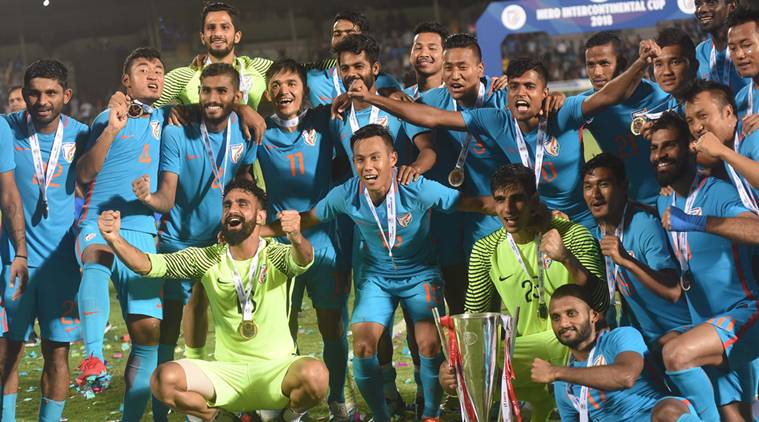 India football team celebrates after winning the final against Kenya during the Intercontinental cup 2018 at Andheri sports club in Mumbai. (Express photo by Kevin DSouza)
India football team celebrates after winning the final against Kenya during the Intercontinental cup 2018 at Andheri sports club in Mumbai. (Express photo by Kevin DSouza)
Sunil Chhetri walked up to Anirudh Thapa, passed on instructions, and then jogged back into the box. It was a free-kick for India on the right edge of the box with an angle too acute for a direct shot.
Chhetri wouldn’t take the free-kick, leaving it for the young midfielder instead. But there was no keeping him away from the action. Inside the six-yard-box, he was dwarfed in front of the towering Kenyan midfielder Patilah Omoto. There would have been no chance for the 33-year-old to win a header against the muscular six-footer. Surely, he knew that.
He crept towards the far post, waiting for the customary jostling and confusion to begin. Then he made his move. His arm didn’t point to the sky to grab Thapa’s attention – his instructions were to keep an eye for the signal. Instead he pointed to an area near the 12-yard penalty spot. That’s where he wanted the ball.
Thapa complied, sending a low-cross where Chhetri had asked, where the captain had stepped back to, away from goal, away from his markers. And once the ball came, Chhetri coolly side-footed past the rooted defence and into the vacant goal.
Inside the first nine minutes of the Intercontinental Cup final against Kenya at the Mumbai Football Arena, India’s talisman had given them the lead and sent them on their way to a comfortable 2-0 win.
That itself had been the trend for the duration of the competition. In each of the four matches India played against Chinese Taipei, New Zealand and Kenya (twice), it was the veteran who opened the scoring for the national team.
The strike in the ninth minute wouldn’t be his only one on the night. India, and Chhetri’s, second came in the 29th minute – another impressive finish to savour.
As the furthest Indian in the attacking third, he was the intended target when centre-back Anas Edathodika sent a long-range pass down the line. Sprinting between two Kenyan defenders, the skipper chested the ball into control with sheer elegance despite moving at a fair rate of knots. He wasted no time to control with his feet, toe-poking instead with his left foot on the volley to slot the ball past goalkeeper Patrick Matasi.
Upping the tempo
In the second half, the visitors upped the tempo as India allowed them possession of the ball. Yet barring a few long-range attempts – that were comprehensively cleared by Gurpreet Singh Sandhu in the India goal – Kenya looked far from scoring.
The match belonged to Chhetri though. His brace was his eight goal of the tournament, taking his tally to 64 – joint second with Lionel Messi in terms of most international goals scored by active players (Cristiano Ronaldo holds the highest with 81). The numbers just piled up for the forward. He even earned his 100th cap this tournament, making him the only Indian after Bhaichung Bhutia to cross a ton.
But Chhetri’s efforts haven’t been to just pile on the personal accolades. Off the field, he’s done his bit to raise support for the squad, even if that meant posting a video on social media of himself pleading to fans to come to the stadium and watch. The numbers immediately soared.
But it’s his contributions on-field that have made the difference, especially since he’s the most experienced player in a team that had started taking shape only once Stephen Constantine returned to coach the national team in 2015.
The coach summed up Chhetri’s involvement: “He’s unbelievably fit, looks after himself, complete professional on and off the pitch and that’s why he can maintain the level of fitness he has. We need him at the Asian Cup. We are a better team with him on the pitch than him off it.”